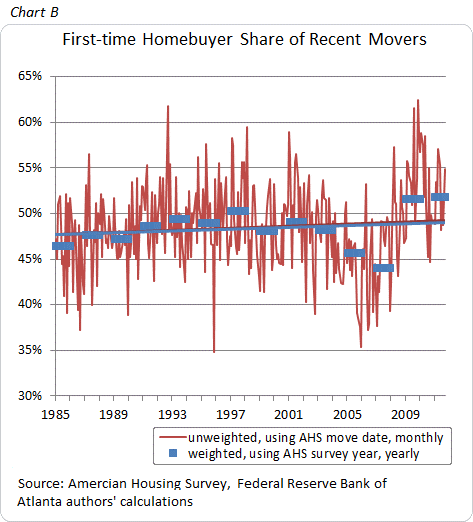Are the numbers of first-time buyers shrinking, victimized by cash-bearing investors, credit-tight lenders mounting mortgage interest rates and soaring home prices? Are they “increasingly getting left behind in the real-estate recovery” as the Journal reported n July?
Well, not exactly, argue two economists from the Atlanta Federal Reserve. Reports based on surveys of Realtors to the contrary, first timers are doing just well as ever, thank you very much. “We do not share the concern about weakness in housing demand going forward because we are not convinced that the data indicates a material decline in first-time buyer participation,” concluded researchers Jessica Dill and Ellyn Terry.
Examining date from the Census Bureau’s American Housing Survey Public Use Microdata and the Campbell/Inside Mortgage Finance HousingPulse Tracking Survey as well as other sources.
Claims of a decline in first-time buyer participation that appear to be based on a comparison of data across different surveys should be treated with caution, they said. There are several sources of data available for tracking the first-time buyer share of market. “In comparing the trends of each series separately, we don’t find there to be much in the way of a material decline in the share of first-time home buyers over the time periods and data series we examined.”
They examined the monthly American Housing Survey time series and he long-term linear trend line from October 1983 through September 2011 was slightly upward-sloping. Many have argued, though, that the first-time homebuyer tax credit program pulled demand forward and that the tax credit period (July 2008-September 2010) distorts the overall long-term trend. Indeed, when we exclude this time period, we find that the slope becomes slightly downward-sloping. They observed a similar trend when we fit a trend line to the National Association of Realtors’ Profile of Home Buyers and Sellers time series. From 2001 through 2012, the trend is slightly upward-sloping when they included the tax credit period and slightly downwardly-sloping when they excluded the tax credit period.
When the effects of the 2009-2010 homebuyer tax credit are removed from the data, numbers of first time home buyers barely changed during that period. “We agree that the tax credit period distorts the trend, we think it is best to exclude it when interpreting the trend in first-time buyer share, and we interpret the trend in the first-time buyer share as flat across each data series when the tax credit period is excluded,” they wrote.

 RealEstateEconomyWatch.com Insight and Intelligence on Residential Real Estate
RealEstateEconomyWatch.com Insight and Intelligence on Residential Real Estate
7 comments
Pingback: False Alarm. First-time Buyers are Not Declining | Belair Realty
Pingback: Number of first-time buyers is not shrinking | Real Estate & Homes For Sale in Alamo, Danville, Blackhawk, San Ramon, Pleasanton and the surrounding Tri-Valley & East Bay Areas.
Pingback: False Alarm. First-Time Buyers Are Not Declining – The Open Door by Lennar
Pingback: False Alarm. First-time Buyers are Not Declining
Pingback: Number of first-time buyers not shrinking? | Coldwell Banker Borrego
Pingback: Tuesday Real Estate & Financial Market News Roundup 9/24/13 — Bay Area Connect
Pingback: False Alarm. First-time Buyers are Not Declining | psiluvrealestate.com